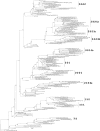Revised and updated nomenclature for highly pathogenic avian influenza A (H5N1) viruses
- PMID: 24483237
- PMCID: PMC4181488
- DOI: 10.1111/irv.12230
Revised and updated nomenclature for highly pathogenic avian influenza A (H5N1) viruses
Abstract
The divergence of the hemagglutinin gene of A/goose/Guangdong/1/1996-lineage H5N1 viruses during 2011 and 2012 (807 new sequences collected through December 31, 2012) was analyzed by phylogenetic and p-distance methods to define new clades using the pre-established nomenclature system. Eight new clade designations were recommended based on division of clade 1·1 (Mekong River Delta), 2·1·3·2 (Indonesia), 2·2·2 (India/Bangladesh), 2·2·1·1 (Egypt/Israel), and 2·3·2·1 (Asia). A simplification to the previously defined criteria, which adds a letter rather than number to the right-most digit of fifth-order clades, was proposed to facilitate this and future updates.
Keywords: H5N1; hemagglutinin; highly pathogenic avian influenza; molecular epidemiology; nomenclature; phylogenetics; viral evolution.
© 2014 The Authors. Influenza and Other Respiratory Viruses Published by John Wiley & Sons Ltd.
Figures

References
Publication types
MeSH terms
Substances
LinkOut - more resources
Full Text Sources
Other Literature Sources
Medical

